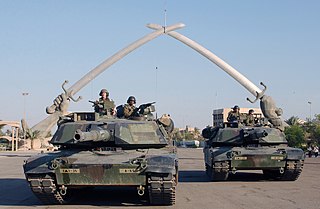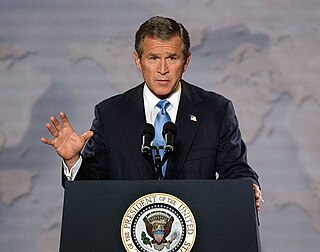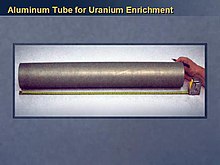
Hans Martin Blix is a Swedish diplomat and politician for the Liberal People's Party. He was Swedish Minister for Foreign Affairs (1978–1979) and later became the head of the International Atomic Energy Agency. As such, Blix was the first Western representative to inspect the consequences of the Chernobyl disaster in the Soviet Union on-site and led the agency's response to them. Blix was also the head of the United Nations Monitoring, Verification and Inspection Commission from March 2000 to June 2003, when he was succeeded by Dimitris Perrikos. In 2002, the commission began searching Iraq for weapons of mass destruction, ultimately finding none. On 17 March 2003, U.S. President George W. Bush delivered an address from the White House announcing that within 48 hours, the United States would invade Iraq unless Saddam Hussein would leave. Bush then ordered all of the weapons inspectors, including Blix's team, to leave Iraq so that America and its allies could invade Iraq on 20 March. In February 2010, Blix became head of the United Arab Emirates' advisory board for its nuclear power program. He is the former president of the World Federation of United Nations Associations.

Iraq actively researched and later employed weapons of mass destruction (WMD) from 1962 to 1991, when it destroyed its chemical weapons stockpile and halted its biological and nuclear weapon programs as required by the United Nations Security Council. The fifth president of Iraq, Saddam Hussein, was internationally condemned for his use of chemical weapons against Iranian and Kurdish civilians during the Iran–Iraq War in the 1980s. Saddam pursued an extensive biological weapons program and a nuclear weapons program, though no nuclear bomb was built. After the Gulf War, the United Nations located and destroyed large quantities of Iraqi chemical weapons and related equipment and materials; Iraq ceased its chemical, biological and nuclear programs.
Iraq's Weapons of Mass Destruction: The Assessment of the British Government, also known as the September Dossier, was a document published by the British government on 24 September 2002. Parliament was recalled on the same day to discuss the contents of the document. The paper was part of an ongoing investigation by the government into weapons of mass destruction (WMD) in Iraq, which ultimately led to the invasion of Iraq six months later. It contained a number of allegations according to which Iraq also possessed WMD, including chemical weapons and biological weapons. The dossier even alleged that Iraq had reconstituted its nuclear weapons programme.

Abdul Qadeer Khan,, known as A. Q. Khan, was a Pakistani nuclear physicist and metallurgical engineer who is colloquially known as the "father of Pakistan's atomic weapons program".

The Commission on the Intelligence Capabilities of the United States Regarding Weapons of Mass Destruction is a panel created by Executive Order 13328, signed by U.S. President George W. Bush in February 2004.
Iran has research sites, two uranium mines, a research reactor, and uranium processing facilities that include three known uranium enrichment plants.

The Senate Report on Iraqi WMD Intelligence was the report by the United States Senate Select Committee on Intelligence concerning the U.S. intelligence community's assessments of Iraq during the time leading up to the 2003 invasion of Iraq. The report, which was released on July 9, 2004, identified numerous failures in the intelligence-gathering and -analysis process. The report found that these failures led to the creation of inaccurate materials that misled both government policy makers and the American public.

The Niger uranium forgeries were forged documents initially released in 2001 by SISMI, which seem to depict an attempt made by Saddam Hussein in Iraq to purchase yellowcake uranium powder from Niger during the Iraq disarmament crisis. On the basis of these documents and other indicators, the governments of the United States and the United Kingdom asserted that Iraq violated United Nations sanctions against Iraq by attempting to procure nuclear material for the purpose of creating weapons of mass destruction.

The Al Qa'qaa' State Establishment was a massive weapons facility 48 kilometres south of Baghdad. It is near to the towns of Yusifiyah and Iskandariya at the geographic coordinates 33°0′54″N44°13′12″E. Covering an area of over 28 km2 (11 sq mi), the site comprises 116 separate factories and over 1,100 structures of various kinds. It is now disused and many of the buildings have been destroyed by bombing, looting and accidental explosions. In October 2004, the facility became the centre of international attention after a UN agency reported hundreds of tonnes of stored explosives "missing".

Iran is not known to currently possess weapons of mass destruction (WMD) and has signed treaties repudiating the possession of WMD including the Biological Weapons Convention, the Chemical Weapons Convention, and the Non-Proliferation Treaty (NPT). Iran has first-hand knowledge of WMD effects—over 100,000 Iranian troops and civilians were victims of chemical weapons during the 1980s Iran–Iraq War.

The White House Iraq Group was a working group of the White House set up in August 2002 and tasked with disseminating information supporting the positions of the George W. Bush administration relating to a possible invasion of Iraq, which would subsequently take place in March 2003.

There are various rationales for the Iraq War that have been used to justify the 2003 invasion of Iraq and subsequent hostilities.

A dispute exists over the legitimacy of the 2003 invasion of Iraq. The debate centers around the question whether the invasion was an unprovoked assault on an independent country that may have breached international law, or if the United Nations Security Council authorized the invasion. Those arguing for its legitimacy often point to Congressional Joint Resolution 114 and UN Security Council resolutions, such as Resolution 1441 and Resolution 678. Those arguing against its legitimacy also cite some of the same sources, stating they do not actually permit war but instead lay out conditions that must be met before war can be declared. Furthermore, the Security Council may only authorise the use of force against an "aggressor" in the interests of preserving peace, whereas the 2003 invasion of Iraq was not provoked by any aggressive military action.

David Albright, M.Sc., is an American physicist and a weapons expert who is the founder of the non-governmental Institute for Science and International Security (ISIS), its current president, and author of several books on proliferation of atomic weapons.
Khidir Hamza is an Iraqi atomic scientist who worked for Saddam Hussein's nuclear programme in the 1980s and early 1990s. Following the Gulf War, he left Iraq in 1994 and went into exile in the United States. He provided testimony to Western intelligence agencies suggesting that Hussein's weapons of mass destruction programmes were active and ongoing. However, claims of active WMD programs including nuclear weapons have since been invalidated, and his self-described role as the former head of Iraq's nuclear weapons programme has been discredited.

Libya pursued programs to develop or acquire weapons of mass destruction from when Muammar Gaddafi seized control of Libya in 1969 until he announced on 19 December 2003 that Libya would voluntarily eliminate all materials, equipment and programs that could lead to internationally proscribed weapons. This included weapons of mass destruction and long-range ballistic missiles.
This article deals with activities of the U.S. Central Intelligence Agency, specifically dealing with arms control, weapons of mass destruction (WMD) and weapons proliferation. It attempts to look at the process of tasking and analyzing, rather than the problem itself, other than whether the CIA's efforts match its legal mandate or assists in treaty compliance. In some cases, the details of a country's programs are introduced because they present a problem in analysis. For example, if Country X's policymakers truly believe in certain history that may not actually be factual, an analyst trying to understand Country X's policymakers needs to be able to understand their approach to an issue.

Prior to the Iraq War, the United States accused Iraq of developing weapons of mass destruction and having links with al-Qaeda. In 1991, the United Nations Security Council Resolution 687 was adopted and subsequent UN weapons inspectors were inside Iraq. This period also saw low-level hostilities between Iraq and the United States-led coalition from 1991–2003.
The Review of Intelligence on Weapons of Mass Destruction, widely known as the Butler Review after its chairman Robin Butler, Baron Butler of Brockwell, was announced on 3 February 2004 by the British Government and published on 14 July 2004. It examined the intelligence on Iraq's weapons of mass destruction which played a key part in the Government's decision to invade Iraq in 2003. A similar Iraq Intelligence Commission was set up in the United States. Despite the apparent certainty of both governments prior to the war that Iraq possessed such weapons, no such illegal weapons or programmes were found by the Iraq Survey Group.













